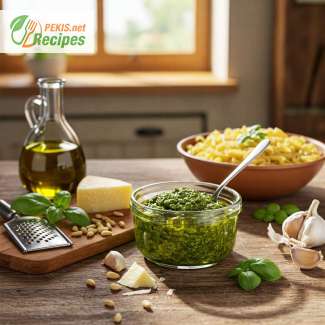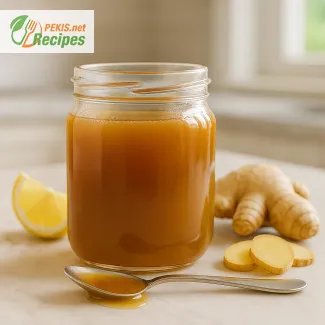
Pesto alla Genovese: A Classic Italian Delight
Introduction to Pesto alla Genovese
Pesto alla Genovese, a dish rooted deeply in the heart of Italian cuisine, is a rich, vibrant, and aromatic sauce that has won the hearts of food enthusiasts around the world. Originating from Genoa, the capital of the Liguria region in northern Italy, this sauce has become a symbol of Italy's rich culinary tradition. With its fresh basil, garlic, pine nuts, and Parmesan cheese, pesto embodies the essence of Mediterranean flavors and is widely used as a pasta dressing, a topping for grilled meats, or even as a spread on fresh bread.
The secret behind pesto alla Genovese lies in the simplicity and quality of its ingredients. The combination of fragrant basil, extra virgin olive oil, and aged cheese creates a balance of flavors that is both robust and delicate. Traditionally, this sauce is prepared using a mortar and pestle, which helps to release the full aroma and flavor of the ingredients. This method of preparation, although time-consuming, is believed to give pesto its distinctive, smooth texture and depth of flavor. However, modern versions of pesto may use a food processor to speed up the process while still achieving a delicious result.
The Core Ingredients of Pesto alla Genovese
What makes pesto alla Genovese stand out is its unique blend of simple ingredients. Fresh basil leaves are the heart of this dish, providing a deep, herbaceous flavor that is both refreshing and earthy. The basil is carefully blended with pine nuts, which add a subtle sweetness and nutty richness to the sauce. Garlic is essential for adding a punch of flavor that elevates the pesto, while Parmesan cheese gives the sauce its signature sharpness and creaminess. Lastly, extra virgin olive oil is used to bring everything together into a silky, smooth texture that coats your pasta beautifully.
Each ingredient plays an integral role in creating the perfect balance of taste and texture. The careful selection of basil, olive oil, and cheese ensures that the sauce is not only full of flavor but also aromatic, leaving a lingering aftertaste that is unmistakable. Pine nuts, although not traditionally grown in Italy’s northern regions, are now a staple in this dish, lending their creamy texture and natural sweetness to the pesto.
The Perfect Way to Enjoy Pesto alla Genovese
Pesto alla Genovese is most commonly paired with pasta, particularly trofie or trenette, which are traditional Ligurian pasta shapes. The rustic shape of these pasta types allows the pesto to cling perfectly to each individual piece, creating a harmonious marriage of flavors in every bite. However, pesto is not limited to pasta alone; it can be used to enhance a variety of dishes. For instance, it can be drizzled over grilled vegetables, chicken, or fish, or even spread on a slice of freshly baked bread for a quick appetizer.
One of the best ways to savor pesto alla Genovese is to allow it to be the star of the dish. By tossing freshly cooked pasta with pesto, you allow the vibrant green sauce to envelop the noodles, creating a dish that is both simple and elegant. The garlic and basil flavors shine through, while the cheese provides a rich and satisfying creaminess. For a truly authentic experience, pair your pesto alla Genovese with a glass of Italian white wine or a dry rosé, allowing the flavors to blend together and create an unforgettable dining experience.
Tips for Making the Best Pesto alla Genovese
While the ingredients are simple, achieving the perfect pesto alla Genovese requires a little attention to detail. First, always use fresh basil—the flavor of the pesto will depend heavily on the quality of the basil used. Look for basil that is deep green, fragrant, and free of any wilting leaves. When making pesto, it's also important to use extra virgin olive oil, as this will contribute to the smooth texture and rich flavor of the sauce. For the best results, use a high-quality, cold-pressed oil to bring out the full depth of flavor.
Another tip is to gently toast the pine nuts before blending them into the pesto. This small step helps to bring out their natural oils and enhances their flavor, giving the pesto a slightly nutty aroma. Additionally, you may want to adjust the amount of garlic according to your taste preference. Some people enjoy a strong garlic flavor, while others prefer a more subtle note. Finally, if you're preparing pesto ahead of time, make sure to store it in an airtight container in the fridge, and add a thin layer of olive oil on top to preserve its vibrant color and fresh taste.
Why Pesto alla Genovese is More Than Just a Sauce
Pesto alla Genovese is more than just a simple sauce—it’s a true expression of Italian culture and tradition. With its origins dating back to the 16th century, pesto has been a beloved staple of Italian cuisine for generations. The dish represents the importance of seasonal ingredients and the Italian practice of making the most of what nature has to offer. It also reflects the simplicity of Italian cooking, where the combination of just a few ingredients can create a dish that is both sophisticated and satisfying.
Whether you are a seasoned chef or a beginner in the kitchen, making pesto alla Genovese is an opportunity to connect with the rich culinary heritage of Italy. Each step in the preparation process, from selecting the freshest basil to grinding the ingredients together, is a tribute to the time-honored traditions that have been passed down through generations. Pesto is a celebration of flavor, simplicity, and creativity, and it continues to be one of the most beloved dishes in Italian cuisine.
In conclusion, pesto alla Genovese is a dish that embodies the essence of Italian cuisine—rich in flavor, history, and tradition. With its fresh ingredients, bold flavors, and versatility, it’s no wonder that pesto has become a favorite around the world. Whether enjoyed in its traditional form with pasta or used as a topping for a variety of dishes, pesto alla Genovese is a timeless classic that will always have a place at the table.
- Prepare the ingredients: Begin by washing the fresh basil leaves thoroughly to remove any dirt or grit. Pat them dry gently using a clean kitchen towel. Peel the garlic cloves. Grate the Parmesan and Pecorino cheese.
- Toast the pine nuts: Lightly toast the pine nuts in a small skillet over medium heat for about 3-4 minutes, shaking the pan occasionally to ensure they don't burn. This step helps bring out the natural flavors of the pine nuts, giving the pesto a deeper richness.
- Blending: In a food processor, combine the fresh basil leaves, toasted pine nuts, garlic, grated Parmesan, and Pecorino. Season with a pinch of salt and pepper. Pulse the ingredients together until they form a coarse paste.
- Add olive oil: Slowly drizzle in the extra virgin olive oil while continuing to blend until the pesto reaches a smooth, creamy consistency. Adjust the amount of olive oil depending on how thick or thin you prefer your pesto.
- Final seasoning: Taste the pesto and adjust the seasoning with more salt and pepper, if desired. The pesto should be rich, aromatic, and slightly creamy from the cheese.
- Serving: Toss the pesto with your favorite pasta, such as trofie or trenette, or use it as a sauce for grilled vegetables or meats. Pesto alla Genovese is perfect for mixing into freshly cooked pasta, where it will cling to the noodles, creating a flavorful and satisfying dish.
How to Enhance and Customize Pesto alla Genovese
Pesto alla Genovese is one of Italy's most beloved sauces, originating from the Liguria region. It is characterized by its vibrant green color and rich, herbaceous flavor, thanks to its key ingredients: fresh basil, pine nuts, garlic, Parmesan cheese, and extra virgin olive oil. Traditionally, the sauce is made by grinding the ingredients together using a mortar and pestle, a technique that ensures the full release of the essential oils from the basil and pine nuts, creating a smooth and flavorful paste. While the classic pesto alla Genovese is perfect as it is, there are a number of variations and adjustments you can make to enhance the flavor profile or tailor it to specific dietary preferences.
In this article, we’ll explore various ways you can customize and improve pesto alla Genovese by tweaking its ingredients, preparation methods, and usage. Whether you're looking to experiment with flavor, texture, or even presentation, these tips will help you create a pesto sauce that fits your unique taste.
Ingredient Variations to Enhance the Flavor
1. Switching the Nuts
One of the most defining ingredients of pesto alla Genovese is the pine nuts. They are prized for their smooth, nutty flavor and creamy texture, but they can be expensive and sometimes difficult to find. If you're looking to change the flavor or make the pesto more affordable, consider substituting pine nuts with other nuts or seeds. Here are a few alternatives:
- Walnuts: Using walnuts instead of pine nuts gives the pesto a deeper, slightly bitter flavor. The robust taste of walnuts pairs well with the basil and garlic, adding richness to the pesto. Walnuts are also a more affordable option compared to pine nuts.
- Almonds: Almonds provide a milder, slightly sweet flavor and a more substantial crunch. They can lend a delightful texture to the pesto and complement the freshness of the basil.
- Sunflower seeds: For those with nut allergies, sunflower seeds are an excellent alternative. They offer a mild, nutty flavor and are often more readily available and cost-effective than pine nuts. Toasted sunflower seeds can provide a similar creaminess and texture to pine nuts.
2. Adding Different Herbs
While basil is the cornerstone of traditional pesto alla Genovese, it’s possible to play around with other herbs to give the sauce a different flavor profile. Some variations of pesto use additional herbs, which can complement or even enhance the flavor of the basil. Try incorporating some of these herbs:
- Mint: Adding a small amount of fresh mint to the pesto can create a refreshing twist. Mint’s slightly sweet and aromatic quality pairs well with basil and can make the pesto taste lighter and more fragrant.
- Arugula: For a peppery kick, adding arugula can balance the sweetness of the basil and provide an extra layer of complexity. The slight bitterness of arugula enhances the overall taste, giving the pesto a more sophisticated edge.
- Oregano or Thyme: These herbs can be used in moderation to add a subtle earthy and savory note to the pesto, giving it more depth and richness. However, be cautious with the amount, as these herbs have a more intense flavor compared to basil.
3. Experimenting with Cheeses
The classic pesto alla Genovese recipe calls for Parmesan and Pecorino Romano, two cheeses that offer a balance of sharpness, saltiness, and creaminess. However, there are many variations of cheeses that can enhance or change the overall taste of the pesto. Some options to consider:
- Grana Padano: If you prefer a smoother, less intense cheese, try using Grana Padano in place of Parmesan. It is slightly milder and has a creamier texture, making it perfect for a more delicate pesto.
- Ricotta Salata: This firm, salt-cured ricotta cheese can lend a salty and crumbly texture to the pesto, adding a bit of complexity to the traditional flavor.
- Pecorino Sardo: Made from sheep’s milk, this cheese is often milder and less tangy than Pecorino Romano, but it still offers a rich creamy and sharp flavor. It can be used in combination with or as a substitute for Pecorino Romano, depending on the desired taste.
4. Altering the Olive Oil
The quality of extra virgin olive oil used in pesto has a profound impact on the final taste of the sauce. A high-quality olive oil brings a rich, fruity flavor that ties the ingredients together beautifully. However, different olive oils can add unique qualities to the pesto. Consider these variations:
- Lemon-infused olive oil: If you're looking to introduce a citrusy note to your pesto, try using lemon-infused olive oil. This variation works especially well when serving pesto with fish or seafood pasta dishes.
- Garlic-infused olive oil: For an even bolder garlic flavor, use garlic-infused olive oil. It will intensify the pesto’s garlic profile and add extra richness.
- Nut oils: For a more decadent version of pesto, experiment with oils like walnut oil or hazelnut oil. These oils add their own distinct nutty flavor, complementing the nuts used in the pesto while creating a velvety texture.
5. Modifying the Garlic
The amount of garlic used in pesto can be adjusted according to personal preference. Some people love a strong garlic presence, while others prefer a subtler hint. To make the garlic flavor more intense, you can:
- Roast the garlic: Roasting the garlic before adding it to the pesto will result in a milder, sweeter garlic flavor that doesn’t overpower the basil and cheese. Roasted garlic adds a caramelized note to the pesto, making it slightly less pungent.
- Use shallots: If you want a more delicate garlic-like flavor, substitute the garlic with finely minced shallots. Shallots provide a sweet and less aggressive flavor than raw garlic, giving the pesto a gentler, smoother taste.
Adjusting the Texture
The texture of pesto is also crucial to its appeal. Some people prefer a smooth, creamy pesto, while others like a more chunky texture. To influence the texture of your pesto, you can:
- Adjust the amount of olive oil: For a thicker pesto, use less olive oil. If you prefer a silkier, more fluid pesto, add more oil gradually while blending.
- Use a mortar and pestle: Traditionalists argue that using a mortar and pestle creates a pesto with a finer, smoother texture because the grinding process helps release the oils and essential oils from the basil and nuts.
- Blend less: If you want a chunkier pesto, pulse the ingredients only a few times rather than blending them until smooth. This will leave larger pieces of basil and nuts, which adds to the texture and mouthfeel.
Serving and Usage Ideas
Once you've perfected your pesto alla Genovese, there are countless ways to serve it. Traditionally, pesto is paired with pasta, but it can be used as a topping for various dishes:
- On grilled meats or vegetables: Drizzle pesto over grilled chicken, lamb, or vegetables for an extra layer of flavor.
- As a spread: Use pesto as a spread on bread, crackers, or bruschetta for an appetizer or snack.
- In sandwiches or wraps: Add pesto to your favorite sandwiches or wraps for a fresh, herby kick.
- With eggs: Mix pesto into scrambled eggs or use it as a topping for poached eggs for a vibrant breakfast option.
While Pesto alla Genovese is a classic sauce with a perfectly balanced flavor profile, there are endless ways to enhance and adapt it. By experimenting with ingredients such as nuts, herbs, cheeses, and oils, you can create a pesto that suits your personal taste or fits your dietary needs. Whether you’re looking to make a pesto that is milder, bolder, or more unique, small adjustments can significantly alter the flavor and texture, allowing you to create a sauce that’s truly one-of-a-kind.
- Contains dairy (Parmesan, Pecorino)
- Contains tree nuts (pine nuts)
- This recipe does not contain gluten, but ensure that the pasta or other dishes you pair it with are gluten-free if necessary.
Substitution tips for allergens and gluten:
- To make the recipe dairy-free, substitute the Parmesan and Pecorino cheeses with a vegan cheese alternative or nutritional yeast for a similar cheesy flavor.
- For those with nut allergies, you can substitute pine nuts with sunflower seeds or pumpkin seeds.
- If you are gluten-sensitive, make sure to serve the pesto with gluten-free pasta or quinoa.
- Vitamin A: Essential for vision and immune function.
- Vitamin K: Important for bone health and proper blood clotting.
- Vitamin C: Boosts the immune system and protects against oxidative stress.
- Calcium: Vital for strong bones and teeth, and necessary for muscle function.
- Iron: Helps carry oxygen in the blood and supports metabolism.
- Basil is rich in flavonoids, which have antioxidant properties that help protect the body against free radical damage.
- Pine nuts contain vitamin E, a powerful antioxidant that helps protect cells from oxidative damage and supports skin health.
- Garlic contains allicin, which has been shown to have antioxidant, anti-inflammatory, and immune-boosting properties.
- Olive oil is packed with polyphenols, which help reduce inflammation and protect heart health.
Pesto alla Genovese is a delightful and simple yet flavorful sauce that adds a vibrant, fresh taste to any dish. Whether you’re making it from scratch or storing it for later use, the fresh ingredients and rich flavors make it a timeless Italian classic that will enhance any meal.





